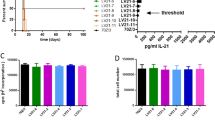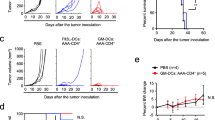Abstract
We have previously reported the development of antitumor effector cells by day 12 after tumor implantation using a murine malignant ascites model with BAMC-1 tumor, which could be cured completely by five consecutive i.p. injections of OK-432 starting on day 2. In contrast, the OK-432 treatment with the same protocol failed to cure the tumor-bearing athymic mice, though it could suppress tumor growth temporarily. The results suggest that T cells may play a critical role in achieving a therapeutic effect. The present study was designed to clarify the nature of the antitumor effector cells induced by OK-432 in euthymic mice. The number of tumor cells in the pertioneal cavity of OK-432-treated euthymic mice increased gradually up to day 12 and dropped suddenly on day 14, while in the athymic mice the tumor cells transiently decreased in the first 7 days then started to expand drastically on day 8. The timing of the appearance of the effector cells was examined by adoptive-transfer experiments. The peritoneal exudate cells (PEC) obtained from BAMC-1 bearing euthymic mice on various days during the treatments with OK-432 were passively transferred intraperitoneally on the respective days (synchronous transfer) or on day 7 (convergent transfer) to BAMC-1-bearing athymic mice, which were treated similarly with OK-432. More than 85% of the recipient athymic mice survived when an adoptive transfer was made on and after day 7. These results indicated that the effector cells developed before day 8 in euthymic mice. The effector cells detectable on day 7 in the PEC represent plastic- or nylon-wool-column-nonadherent cells, which could cure the tumor-bearing athymic mice. Furthermore, the effector cells were destroyed when the nylon-wool-column-nonadherent cells were treated with an anti-L3T4 antibody and complement whereas the same treatment with anti-Lyt2 antibody had no effect. These L3T4+ cells did not possess asialo-GM1 antigen. Although the exact mechanism of action of the effector cells is yet to be clarified, the induction of human equivalents of this type of effector cell would be a good parameter indicative of clinical effects induced by OK-432 or other biological response modifiers in an individual cancer patient.
Similar content being viewed by others
References
Ackermann MF, Lamm KR, Wiegand GW, Luster MI (1989) Antitumor activity of murine neutrophils demonstrated by cytometric analysis. Cancer Res 49: 528
Chang JCC, Moorhead JW (1986) Hapten-specific, class II-restricted killing by cloned T cells: direct lysis and production of a cytolytic factor. J Immunol 136: 2826
Erb P, Grogg D, Troxler M, Kennedy M, Fluri M (1990) CD4+ T cell-mediated killing of MHC class II-positive antigen-presenting cells: I. Characterization of target cell recognition by in vivo or in vitro activated CD4+ killer cells. J Immunol 144: 790
Fujii Y, Kimura S, Sendo F (1987) In vivo antitumor effect of lymphokine activated rodent polymorphonuclear leukocytes. Cancer Res 47: 6000
Hojo H, Hashimoto Y (1981) Cytotoxic cells induced in tumor-bearing rats by a streptococcus preparation (OK-432). Gann 72: 692
Kosugi A, Yoshioka T, Suda T, Sano H, Takahama Y, Fujiwara H, Hamaoka T (1987) The activation of L3T4+ helper T cells assisting the generation of anti-tumor Lyt2+ cytotoxic T lymphocytes: requirement of Ia-positive antigen-presenting cells for processing and presentation of tumor antigens. J Leukocyte Biol 42: 632
Lichtenstein AK, Berek J, Kahle J, Zighlboim J (1894) Role of inflammatory neutrophils in antitumor effects induced by intraperitoneal administration ofCorynebacterium parvum in mice. Cancer Res 44: 5118
Morikawa K, Takeda R, Yamazaki M, Mizuno D (1985) Induction of tumoricidal activity of polymorphonuclear leukocytes by a linear β-1,3-d-glucan and other immunomodulators in murine cells. Cancer Res 45: 1496
Nakajima H, Fujiwara H, Takai Y, Izumi Y, Sano S, Tsuchida T, Hamaoka T (1985) Studies on macrophage-activated factor (MAF) in antitumor immune responses: I. Tumor-specific Lyt-1+2− T cells are required for producing MAF able to generate cytolytic as well as cytostatic macrophages. J Immunol 135: 2199
Nakamura M, Ross DT, Briner TJ, Gefter ML (1986) Cytolytic activity of antigen-specific T cells with helper phenotype. J Immunol 136: 44
Nishimura T, Nakamura Y, Takeuchi Y, Gao X, Tokuda Y, Okumura K, Habu S (1991) Bispecific antibody-directed antitumor activity of human CD4+ helper/killer T cells induced by anti-CD3 monoclonal antibody plus interleukin 2. Jpn J Cancer Res 82: 1207
Ozaki S, Suginoshita T (1989) Biological response modifier as antigen: OK-432-specific T cell clone as an anti-tumor effector cell. Cell Immunol 120: 477
Saito M, Nanjo M, Aonuma E, Noda T, Nakadate I, Ebina T, Ishida N (1984) Activated macrophages are responsible for the tumor-inhibitory effect in mice receiving intravenous injection of OK-432. Int J Cancer 33: 271
Saito M, Ichimura O, Kataoka M, Moriya Y, Ueno K, Sugawara Y, Nanjo M, Ishida N (1986) Pronounced antitumor effect of LAK-like cells induced in the peritoneal cavity of mice after intraperitoneal injection of OK-432, a killed streptococcal preparation. Cancer Immunol Immunother 22: 161
Saito M, Nanjo M, Kataoka M, Moriya Y, Sugawara Y, Yoshida T, Ishida N (1988) Adoptive immunotherapy by pantropic killer cells recovered from OK-432-injected tumor sites in mice. Cancer Res 48: 4163
Sakaguchi M, Takahashi H, Zeniya M, Ohkawa Y, Okuaki Y, Tsuno S, Hokari A, Ishikawa T, Karasawa T, Hara M, Kawabe T, Aizawa Y, Kameda H, Yoshida T (1991) Phenotypical and cytotoxical changes of the lymphocytes in peritoneal fluids of cancer patients after intraperitoneal administration of OK-432 — comparison of effective and ineffective cases. In: Digestive organ and immunology. (Tsuchiya, M., Ed.) Nihon-igakukan Press, Tokyo, p 266
Sakurai Y, Tsukagoshi S, Sato H, Akiba T, Suzuki S, Takagaki Y (1972) Tumor-inhibitory effect of a streptococcal prepartion (NSCB116209). Cancer Chem Rep 569: 36
Talmage IE, Herberman RB (1986) Evaluation of imunomodulatory and therapeutic properties of biological response modifiers. Cancer Treat Rep 70: 171
Tite JP, Janeway CA Jr (1984) Cloned helper T cells can kill B lymphoma cells in the presence of specific antigen: I a restriction and cognate vs. noncognate interactions in cytolysis. Eur J Immunol 14: 878
Torisu M, Katano M, Kimura Y, Itoh H, Takesue M (1983) New approach to management of malignant ascites with a streptococcal preparation, OK-432: I. Improvement of host immunity and prolongation of survival. Surgery 93: 357
Katano M, Torisu M (1983) New approach to management of malignant ascites with a streptococcal preparation, OK-432: II. Intraperitoneal inflammatory cell-mediated tumor cell destruction. Surgery 93: 365
Uchida A, Hoshino T (1980) Clinical studies on cell-mediated immunity in patients with malignant disease. Cancer 45: 476
Uchida A, Micksche M (1983) Lysis of fresh human tumor cells by autologous peripheral blood lymphocytes and pleural effusion lymphocytes activated by OK-432. JNCI 71: 673
Watanabe Y, Iwa T (1984) Clinical value of immunotherapy for lung cancer by the streptococcal preparation OK-432. Cancer 53: 248
Watabe S, Sendo F, Kimura S, Arai S (1984) Activation of cytotoxic polymorphonuclear leukocytes by in vivo administration of a streptococcal preparation, OK-432. JNCI 72: 1365
Yamagishi H, Peris NR, Kahan BD (1980) Streptococcal immunotherapy of a chemical induced murine fibrosarcoma: effect of dose, route, sham surgery and splenectomy on adjuvant action. Cancer Immunol Immunother 9: 63
Yamamoto H, Takata M, Fujimoto S (1987) The role of L3T4-positive T lymphocytes in the generation of anti-tumor immunity in the mouse. Jpn J Cancer Res 78: 176
Author information
Authors and Affiliations
Rights and permissions
About this article
Cite this article
Moriya, Y., Sato, H., Ito, K. et al. Induction of antitumor L3T4-positive T cells by OK-432 at tumor sites in mice. Cancer Immunol Immunother 36, 245–250 (1993). https://doi.org/10.1007/BF01740906
Received:
Accepted:
Issue Date:
DOI: https://doi.org/10.1007/BF01740906




